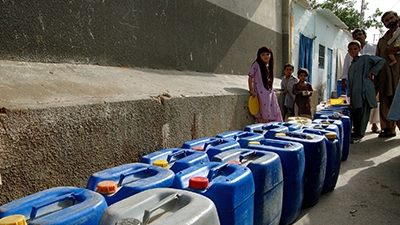On the heels of an initial citizen report card survey, the Karachi Water and Sewerage Board (KW&SB) in Pakistan saw an urgent need to categorize, document, and update its database of water coverage, number of consumers, payment status, and profiles of individuals. The survey revealed high user satisfaction but low revenue generation in seven of the nine towns surveyed in the City of Karachi. Low revenue generation for KW&SB means they will lack the required resources to provide services for the poorest citizens.
To better understand the gap between satisfaction and revenue generation, Gulberg Town, where 30 percent of its more than 1.2 million inhabitants live in slums, was selected to pilot a household survey. Gulberg Town was also selected because almost 21 percent of low-income town dwellers were getting services from water tankers managed by another administrative agency in Karachi. The water quality of this unregulated supply channel is a hazard that can cause waterborne diseases, resulting in poor health, children missing school, and loss of productivity in the labor force, among other risks. Not only do the water tankers pose health concerns, they also cost consumers at – least three times more than the service through KW&SB.
Survey findings
The survey revealed that in a significant number of households additional floors (that according to existing policy are billed 50 percent of what a ground floor unit is billed) were added but not recorded. According to rough estimates, around 8,000 to 10,000 additional floors in Gulberg Town are missing from the KW&SB billing record. At present tariff rates, additions to the monthly KW&SB bill will be around $5,000 (Rs. 500,000) per month if they are billed. In addition, long time defaulters that had never been approached earlier for recovery were identified.
Not all findings focused on revenue. The initial survey indicated that interactions with the KW&SB officials were extremely rare in most towns. Over 26 percent of the households in the nine towns did not think interaction would make any difference, while over 19 percent did not know where and with whom they were supposed to interact. In cases of service delivery issues, households generally approached the officials of the City District Government Karachi through union counselors (43 percent), or the council chairs (37 percent).
The consumer survey has helped changed those perceptions. The KW&SB senior officials approached the consumers directly and requested settlement of their outstanding dues offering attractive rebates, and were well received.
A prominent health facility of the city agreed immediately to pay past due amounts of $2,000 (Rs. 200,000) in four installments of $500 (Rs. 50,000) each. It has not all been about recovery. Consumer data, when updated, has also brought out cases of incorrect billing. A public school that was earlier not metered was being billed via both (usage based and flat rate) types of service payment and there was a lack of communication between the consumer and the utility.
The survey in Gulberg Town has already started paying dividends. According to the chief engineer of internal reforms and the head of the Citizen Report Card/Performance Benchmarking (CRC/PBM) Cell, a major focus of the consumer survey was the updating of the consumer data leading to enhancement in revenue generation, and it has already been indicated that a large number of households, earlier not in the “tax net,” have been identified. In addition, a detailed profiling of the defaulters is being done, which had never been attempted at the retail level in the past. The greatest percentage of “new” revenue-enhancement points identified has been in the form of additional floors added to existing household units. The KW&SB does not provide metered water supply to retail consumers, and billing is done on a flat rate based on the plot size.
The process and subsequent results have strengthened the belief of the KW&SB management that the benefits achieved through this process can be sustained over the long run. The consumers have appreciated and supported this positive engagement of the KW&SB officials while at the senior management and decision making level, significant policy decisions and administrative adjustments have taken place to ensure that the learning from one town benefits the other 17 towns of Karachi through a continued institutional process.

